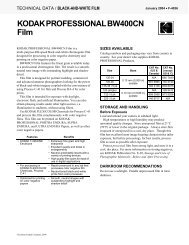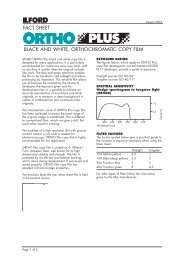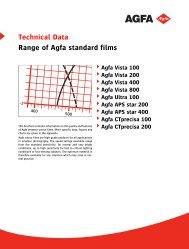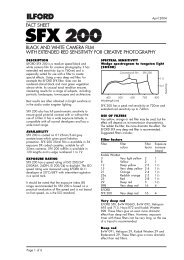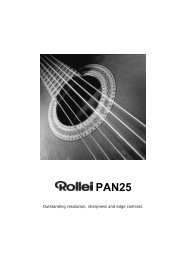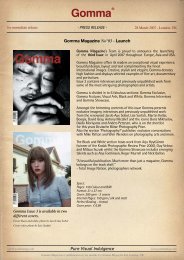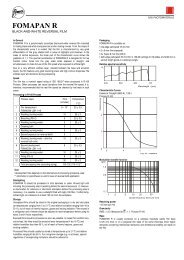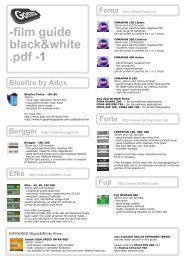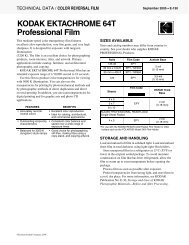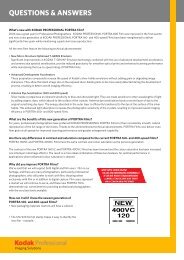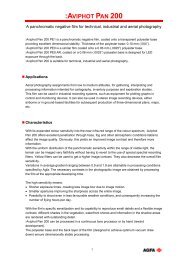KODAK ULTRA MAX 400 Film - Gomma
KODAK ULTRA MAX 400 Film - Gomma
KODAK ULTRA MAX 400 Film - Gomma
You also want an ePaper? Increase the reach of your titles
YUMPU automatically turns print PDFs into web optimized ePapers that Google loves.
<strong>KODAK</strong> <strong>ULTRA</strong> <strong>MAX</strong> <strong>400</strong> <strong>Film</strong><br />
TECHNICAL DATA / COLOR NEGATIVE FILM<br />
February 2007 • E-7019<br />
<strong>KODAK</strong> <strong>ULTRA</strong> <strong>MAX</strong> <strong>400</strong> <strong>Film</strong> is a worry-free, easy-to-use<br />
high speed film designed for snapshooters. <strong>ULTRA</strong> <strong>MAX</strong><br />
<strong>400</strong> <strong>Film</strong> gives you the flexibility you need to take<br />
consistently better pictures in more picture taking<br />
situations—better low-light picture quality with fewer<br />
underexposures, better results with zoom lenses, greater<br />
flash range, better "stop-action" photos, and reduced<br />
impact of camera shake.<br />
Even when enlarged, <strong>ULTRA</strong> <strong>MAX</strong> <strong>400</strong> <strong>Film</strong> delivers<br />
excellent sharpness and fine grain for crisp, clear pictures.<br />
Optimized color precision technology provides<br />
consistently bright, vibrant colors with accurate skin-tone<br />
reproduction for natural-looking people pictures.<br />
<strong>ULTRA</strong> <strong>MAX</strong> <strong>400</strong> <strong>Film</strong> is designed for processing in<br />
<strong>KODAK</strong> FLEXICOLOR Chemicals for Process C-41. It is<br />
printing compatible with <strong>KODAK</strong> GOLD <strong>Film</strong>s.<br />
FEATURES ADVANTAGES BENEFIT<br />
• Advanced<br />
T-GRAIN Emulsion<br />
technology<br />
• Antenna dye<br />
sensitization<br />
• Advanced<br />
development<br />
accelerators<br />
• Optimized color<br />
precision<br />
technology<br />
• Highest effective<br />
speed of any<br />
consumer <strong>400</strong><br />
offering<br />
• Better<br />
underexposure<br />
protection<br />
• Long flash range<br />
• Fine grain and<br />
high sharpness<br />
• Great skin tones<br />
and superb color<br />
• Better pictures<br />
under more<br />
conditions (inside,<br />
outside, bad light,<br />
fast action)<br />
EXPOSURE<br />
<strong>Film</strong> Speed: ISO/DIN <strong>400</strong>/27°<br />
Use these speed numbers in the table below with cameras<br />
or meters marked for ISO, ASA, or DIN speeds or exposure<br />
indexes. Do not change the film-speed setting when you<br />
use a filter if your camera has through-the-lens metering.<br />
For critical work, make a series of test exposures.<br />
Daylight<br />
Use the exposures in the table below for average frontlit<br />
subjects from 2 hours after sunrise to 2 hours before<br />
sunset.<br />
Lighting Conditions<br />
Shutter<br />
Speed<br />
(seconds)<br />
*Use f/5.6 for backlit close-up subjects.<br />
†Subject shaded from the sun but lighted by a large area of sky.<br />
Lens<br />
Opening<br />
Bright/Hazy Sun on Light Sand or<br />
Snow<br />
1/500 f/16<br />
Bright or Hazy Sun (Distinct<br />
Shadows) * 1/500 f/11<br />
Weak, Hazy Sun (Soft Shadows) 1/500 f/8<br />
Cloudy Bright (No Shadows) 1/500 f/5.6<br />
Heavy Overcast, Open Shade † 1/500 f/4<br />
STORAGE AND HANDLING<br />
Load and unload your camera in subdued light.<br />
Store unexposed film at 21°C (70°F) or lower in the<br />
original sealed package. Always store film (exposed or<br />
unexposed) in a cool, dry place. Process film as soon as<br />
possible after exposure.<br />
Protect negatives from strong light, and store them in a<br />
cool, dry place. For more information on storing negatives,<br />
see <strong>KODAK</strong> Publication No. E-30, Storage and Care of<br />
<strong>KODAK</strong> Photographic Materials—Before and After<br />
Processing.<br />
DARKROOM RECOMMENDATIONS<br />
Do not use a safelight. Handle unprocessed film in total<br />
darkness.<br />
©Eastman Kodak Company, 2007
Electronic Flash:<br />
Use the appropriate guide number in the table below as a<br />
starting point for your equipment. Select the unit output<br />
closest to the number given by your flash manufacturer.<br />
Then find the guide number for feet or metres.<br />
To determine the lens opening, divide the guide number<br />
by the flash-to-subject distance. If negatives are too dark<br />
(overexposed), use a higher guide number; if they are too<br />
light (underexposed), use a lower number.<br />
Unit Output<br />
Guide Number<br />
(BCPS) *<br />
Distance in Feet Distance in Meters<br />
350 85 26<br />
500 100 30<br />
700 120 36<br />
1000 140 42<br />
1<strong>400</strong> 170 50<br />
2000 200 60<br />
2800 240 70<br />
<strong>400</strong>0 280 85<br />
5600 340 105<br />
8000 <strong>400</strong> 120<br />
*BCPS = beam candlepower seconds<br />
Automatic Flash Units: Set ISO / ASA selector to <strong>400</strong>.<br />
Fluorescent and High-Intensity Discharge Lights<br />
For best results without special printing, use the<br />
color-correction filters in the table below as starting points<br />
when you expose these films under fluorescent and<br />
high-intensity discharge lamps. Use exposure times of<br />
1/60 second or longer to avoid the brightness and color<br />
variations that occur during a single alternating-current<br />
cycle.<br />
Though this film is tolerant of mixed-lighting situations,<br />
for best color results under uniform fluorescent or<br />
high-intensity discharge sources, use the exposure and<br />
filter recommendations given below. These<br />
recommendations are starting points.<br />
Actual filtration may vary between lamps and lamp<br />
manufacturers. Depending on the specific source,<br />
additional filtration or special printing may be required to<br />
achieve best results.<br />
Type of<br />
Fluorescent<br />
Lamp<br />
<strong>KODAK</strong> Color<br />
Compensating Filters<br />
Exposure Adjustment<br />
Daylight 40R + 2 ⁄3 stop<br />
White 20C + 30M + 1 stop<br />
Warm White 40B + 1 stop<br />
Warm White<br />
Deluxe<br />
30B + 30C<br />
+ 1 1 ⁄3 stops<br />
Cool White 30M + 2 ⁄3 stop<br />
Cool White<br />
Deluxe<br />
10C + 10M<br />
+ 2 ⁄3 stop<br />
Note: When you do not know the type of fluorescent<br />
lamps, try a 10C + 20M filter combination and increase<br />
exposure by 2 ⁄3 stop; color rendition may be less than<br />
optimum.<br />
Type of High-Intensity<br />
Discharge Lamp<br />
<strong>KODAK</strong> Color<br />
Compensating<br />
Filters<br />
Exposure<br />
Adjustment<br />
High Pressure Sodium Vapor 70B + 50C + 3 stops<br />
Metal Halide 10R + 20M + 2 ⁄3 stop<br />
Mercury Vapor with Phosphor 20R + 20M + 2 ⁄3 stop<br />
Mercury Vapor without<br />
Phosphor<br />
80R + 1 2 ⁄3 stops<br />
Note: Some primary color filters were used in the tables<br />
above to reduce the number of filters and/or to keep the<br />
exposure adjustment to a minimum. Red filters were<br />
substituted for equivalent filtration in magenta and yellow.<br />
Blue filters were substituted for equivalent filtration in cyan<br />
and magenta.<br />
Adjustments for Long and Short Exposures<br />
You do not need to make any exposure or filter adjustments<br />
for exposure times of 1/10,000 second to 10 seconds.<br />
Exposures longer than 10 seconds may require<br />
compensation and filtration.<br />
2 <strong>KODAK</strong> <strong>ULTRA</strong> <strong>MAX</strong> <strong>400</strong> <strong>Film</strong> • E-7019
PROCESSING<br />
Process in <strong>KODAK</strong> FLEXICOLOR Chemicals for Process<br />
C-41.<br />
Information on replenishment rates is available online at<br />
www.kodak.com/go/photofinishing.<br />
JUDGING NEGATIVE EXPOSURES<br />
You can check the exposure level of the color negative with<br />
a suitable electronic densitometer equipped with a filter<br />
such as the red filter for Status M Densitometry or a<br />
<strong>KODAK</strong> WRATTEN Gelatin Filter No. 92. Depending on the<br />
subject and the light source used for exposure, a normally<br />
exposed color negative measured through the red filter<br />
should have the approximate densities listed below. These<br />
densities apply for the recommended light sources and<br />
correct processing of the negative.<br />
Densities of Properly Exposed and Processed Negatives<br />
Area Measured on the Negative<br />
Density<br />
Reading<br />
The <strong>KODAK</strong> Gray Card * (gray side) receiving the<br />
same illumination as the subject<br />
0.80 to 1.00<br />
The lightest step (darkest in the negative) of a<br />
<strong>KODAK</strong> Paper Gray Scale receiving the same 1.20 to 1.40<br />
illumination as the subject<br />
Normally lighted forehead of person with light<br />
complexion † 1.10 to 1.40<br />
Normally lighted forehead of person with dark<br />
complexion † 0.85 to 1.25<br />
* <strong>KODAK</strong> Publication No. R-27<br />
†Because of the extreme range in skin color, use these values only as a guide.<br />
For best results, use a <strong>KODAK</strong> Gray Card (gray side).<br />
PRINTING NEGATIVES<br />
This film is optimized for printing on <strong>KODAK</strong> EKTACOLOR<br />
EDGE Paper, <strong>KODAK</strong> ROYAL Digital Color Paper, and<br />
<strong>KODAK</strong> PROFESSIONAL ENDURA Metallic Paper.<br />
Make color slides and transparencies by printing the<br />
negatives on <strong>KODAK</strong> PROFESSIONAL ENDURA<br />
Transparency Display Material or <strong>KODAK</strong><br />
PROFESSIONAL ENDURA Clear Display Material.<br />
You can scan an image to a file and print digitally to<br />
<strong>KODAK</strong> EKTACOLOR EDGE Paper, <strong>KODAK</strong> ROYAL Digital<br />
Color Paper, <strong>KODAK</strong> PROFESSIONAL ENDURA Papers,<br />
<strong>KODAK</strong> PROFESSIONAL ENDURA Metallic Paper,<br />
<strong>KODAK</strong> PROFESSIONAL ENDURA Transparency Display<br />
Material, or <strong>KODAK</strong> PROFESSIONAL ENDURA Clear<br />
Display Material.<br />
Make black-and-white prints on any of the materials<br />
mentioned above using the recommendations in <strong>KODAK</strong><br />
Publication CIS-274, Printing Black-and-White Images<br />
Without <strong>KODAK</strong> Black-and-White Papers.<br />
RETOUCHING<br />
Negatives on this film can be retouched on the emulsion<br />
side with retouching pencils, after applying a retouching<br />
fluid, such as <strong>KODAK</strong> Retouching Fluid.<br />
IMAGE STRUCTURE<br />
Print Grain Index Magnification Table:<br />
The Print Grain Index number refers to a method of<br />
defining graininess in a print made with diffuse-printing<br />
illumination. It replaces rms granularity and has a different<br />
scale which cannot be compared to rms granularity.<br />
This method uses a uniform perceptual scale, with a<br />
change for four units equaling a just noticeable difference<br />
in graininess for 90 percent of observers.<br />
A Print Grain Index rating of 25 on the scale represents<br />
the approximate visual threshold for graininess. A<br />
higher number indicates an increase in the amount of<br />
graininess observed.<br />
The standardized inspection (print-to-viewer) distance<br />
for all print sizes is 14 inches, the typical viewing<br />
distance for a 4 x 6-inch print.<br />
In practice, larger prints will likely be viewed from<br />
distances greater than 14 inches, which reduces<br />
apparent graininess.<br />
Print Grain Index numbers may not represent graininess<br />
observed from more specular printing illuminants, such<br />
as condenser enlargers.<br />
The Print Grain Index numbers listed in this publication<br />
apply to the following standards:<br />
Negative Size:<br />
24 x 36 mm<br />
(135-size standard format)<br />
Print Size:<br />
4 x 6 inches<br />
(10.2 x 15.2 cm)<br />
Magnification: 4.4X<br />
Print Grain Index: 46<br />
<strong>KODAK</strong> <strong>ULTRA</strong> <strong>MAX</strong> <strong>400</strong> <strong>Film</strong> • E-7019 3
CURVES<br />
Characteristic Curves<br />
Spectral-Sensitivity Curves<br />
4.0<br />
3.0<br />
Exposure: Daylight<br />
Process: C-41<br />
Densitometry: Status M<br />
B<br />
*<br />
4.0<br />
3.0<br />
Effective Exposure: 1/100 sec<br />
Exposure: Daylight<br />
Densitometry: Status M Magenta-<br />
Density: 0.2>D-min<br />
Forming<br />
Layer<br />
DENSITY<br />
2.0<br />
G<br />
R<br />
LOG SENSITIVITY<br />
2.0<br />
1.0<br />
Yellow-<br />
Forming<br />
Layer<br />
Cyan-<br />
Forming<br />
Layer<br />
1.0<br />
0.0<br />
-4.0 -3.0 -2.0 -1.0 0.0 1.0<br />
E7019A LOG EXPOSURE (lux-seconds)<br />
0.0<br />
250<br />
300<br />
350<br />
<strong>400</strong> 450 500 550 600<br />
WAVELENGTH (nm)<br />
650<br />
*Sensitivity = reciprocal of exposure (erg/cm ) required<br />
to produce specified density<br />
2<br />
700 750<br />
Spectral-Dye-Density Curves<br />
DIFFUSE SPECTRAL DENSITY<br />
2.5<br />
2.0<br />
1.5<br />
1.0<br />
0.5<br />
Typical densities for a midscale neutral subject<br />
and D-min.<br />
Process: C-41<br />
Minimum Density<br />
Midscale Neutral<br />
0.0<br />
<strong>400</strong> 500<br />
600<br />
WAVELENGTH (nm)<br />
700<br />
NOTICE: The sensitometric curves and data in this publication represent product tested<br />
under the conditions of exposure and processing specified. They are representative of<br />
production coatings, and therefore do not apply directly to a particular box or roll of<br />
photographic material. They do not represent standards or specifications that must be<br />
met by Eastman Kodak Company. The company reserves the right to change and<br />
improve product characteristics at any time.<br />
<strong>KODAK</strong> <strong>ULTRA</strong> <strong>MAX</strong> <strong>400</strong> <strong>Film</strong> • E-7019 4
MORE INFORMATION<br />
Kodak has many publications to assist you with<br />
information on Kodak products, equipment, and materials.<br />
Additional information is available on the Kodak<br />
website.<br />
The following publications are available from Kodak<br />
Customer Service and from dealers who sell Kodak<br />
products, or you can contact Kodak in your country for<br />
more information.<br />
E-30 Storage and Care of <strong>KODAK</strong> Photographic Materials—<br />
Before and After Processing<br />
E-7022 <strong>KODAK</strong> GOLD 100 and 200 <strong>Film</strong>s<br />
E-7018 <strong>KODAK</strong> <strong>ULTRA</strong> <strong>MAX</strong> 800 <strong>Film</strong><br />
E-4035 <strong>KODAK</strong> PROFESSIONAL <strong>ULTRA</strong> COLOR <strong>Film</strong>s<br />
E-4040 <strong>KODAK</strong> PROFESSIONAL PORTRA <strong>Film</strong>s<br />
E-7020 <strong>KODAK</strong> EKTACOLOR EDGE Paper<br />
E-7021 <strong>KODAK</strong> ROYAL Digital Color Paper<br />
E-4020 <strong>KODAK</strong> PROFESSIONAL <strong>ULTRA</strong> ENDURA Paper<br />
E-4021 <strong>KODAK</strong> PROFESSIONAL PORTRA and SUPRA ENDURA<br />
Papers<br />
E-4038 <strong>KODAK</strong> PROFESSIONAL ENDURA Transparency and Clear<br />
Display Materials<br />
For the latest version of technical support publications for <strong>KODAK</strong><br />
Products, visit Kodak on-line at:<br />
http://www.kodak.com<br />
If you have questions about <strong>KODAK</strong> Products, call Kodak.<br />
In the U.S.A.:<br />
1-800-242-2424, Monday–Friday<br />
9 a.m.–7 p.m. (Eastern time)<br />
In Canada:<br />
1-800-465-6325, Monday–Friday<br />
8 a.m.–5 p.m. (Eastern time)<br />
Note: The Kodak materials described in this publication<br />
are available from dealers who supply Kodak products.<br />
You can use other materials, but you may not obtain<br />
similar results.<br />
<strong>KODAK</strong> <strong>ULTRA</strong> <strong>MAX</strong> <strong>400</strong> <strong>Film</strong> • E-7019 5
<strong>KODAK</strong> <strong>ULTRA</strong> <strong>MAX</strong> <strong>400</strong> <strong>Film</strong><br />
Kodak, Kodak Professional, Edge, Ektacolor, Endura, Flexicolor, Gold, Max, Portra, Royal,<br />
Supra, T-Grain, Ultra, and Wratten are trademarks.<br />
Revised 2-07<br />
Printed in U.S.A.<br />
<strong>KODAK</strong> <strong>ULTRA</strong> <strong>MAX</strong> <strong>400</strong> <strong>Film</strong><br />
<strong>KODAK</strong> Publication No. E-7019<br />
CAT 101 5387<br />
<strong>Film</strong> & Photofinishing Systems Group<br />
EASTMAN <strong>KODAK</strong> COMPANY • ROCHESTER, NY 14650




